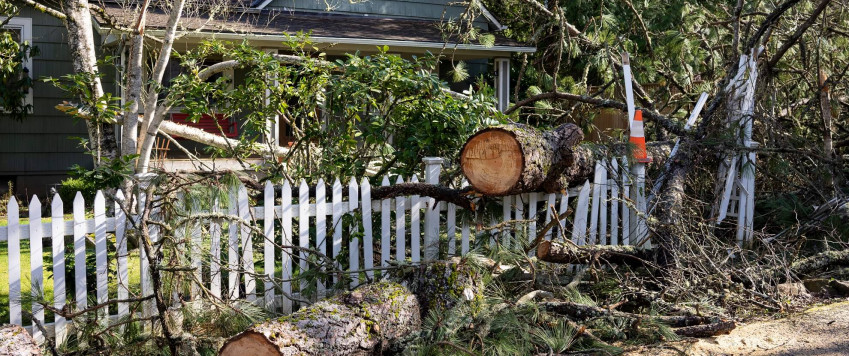Natural disaster strikes: how to tame the loss monster?
Simulation of the Effect of Natural Disasters on the Latvian Economy and Insurance Sector

In line with the need to test the resilience of the financial sector to climate risks, we have developed a model to simulate the impact of natural disasters on Latvia's economic development in general and on the insurance sector in particular.
In short
-
Natural disasters can strike us anytime, so it is up to us to be prepared. Insurance is only a small branch to reach to in case of a disaster. It is even more important to invest in adaptation and to make the right decisions regarding the location of your assets.
-
By 2050, simulated damages can range from 1% of GDP if only the usual (average) storms, rain floods and spring floods hit Latvia, to 7.6% of GDP if all three kinds of major natural disasters occur.
-
In most of our simulations, Latvia's GDP in 2050 is 1–5% lower than its initial value due to the damages caused by natural disasters and a comparatively low share of insured damages.
-
A properly designed insurance scheme can be self-sustained (except for a couple of years at the beginning) and facilitate the increase in the number of insured properties, reducing the negative effects of natural disasters on economic growth. However, without a clear action plan afterwards, all the positive effects can fade away.
Starting point: the damages caused by natural disasters and the share of insured damages
To evaluate the impact of natural disasters, first, we must know when we can expect them and how large they can be. We used the EM-DAT database to gain insights regarding natural disasters in Eastern and Northern Europe and a mix of local sources (disasters, wind speed, precipitation, and water levels in rivers) to evaluate the values needed for modelling. In particular, we were interested in the mean damages that could be registered each year and the maximum damages that could be registered with a particular frequency/probability.
Our maximum damage estimates are based on:
- the data on Storm Erwin (in 2005) from the EM-DAT database: it caused damages worth 356 million euro or 2.5% of GDP,
- the data on rain floods in Latgale (in 2017) from the EU Solidarity Fund data: they caused damages worth 380,5 million euro or 1.4% of GDP,
- the data on spring flood damages estimated by the LEGMC (2019) for 200-year floods: they can cause damages worth 209.1 million euro or 0.7% of GDP.
For the mean damage estimates, we used the LEGMC (2019) estimates and the estimates provided by the Ministry of Environmental Protection and Regional Development (VARAM) 2017, combining data on coastal and spring floods and wind and rain damages. Our base values were 0.21% of GDP for storms, 0.06% of GDP for rain floods and 0.26% of GDP for spring floods.
As a result, by 2050, damages can range from 1% of GDP if only mean damages are registered, to 7.6% of GDP if all three kinds of major natural disasters occur. We assumed that we can expect 1–2 large storms, 3–6 large rain floods and 7 spring floods until 2050. We applied the Monte Carlo simulation to assign natural disasters to particular quarters. To give a clearer idea, we present the results of one simulation in Chart 1.
To evaluate the share of insured damages, we took into account the possible share of insured properties (in terms of value), risk coverage in insurance policies and the share of refused claims. We based our assumptions regarding the share of insured properties on the data of the ERGO security index [1] and information from the Latvian Insurers Association (LAA) [2]. We assumed that the initial share of insured properties might constitute 50% and it can further increase proportionally to GDP growth and more rapidly after significant natural disasters.
The LAA data show that natural disaster risks are included in 30% of real estate insurance policies and 1–6% of car insurances. Therefore, we assumed that the insurance coverage for storms is included in 40% of policies, for rain floods – in 30% of policies and for spring floods – in 5% of policies. The respective coverage could increase to 60%, 40% and 10% by 2050. These shares temporarily increase after large natural disasters following the observations made by the insurers about an increase in the number of purchased policies after such events.
We also take into consideration that not all the claims are satisfied. According to the LAA data, the refusal rate is 9–30% with the mean value of 18%. As a result, the share of insured damages was calculated using the data on the share of insured properties, the natural disaster coverage and refusal rate. One of 10 000 versions is displayed in Chart 2.
Effect on GDP and the insurance sector: the base scenario
In order to get realistic estimates of the effect of natural disasters on GDP, we followed the results of Rousova et al (2021) in our model. Namely, if a country is hit by a disaster that causes damages worth 1% of GDP, the GDP growth rate decreases by 0.25 percentage points. However, if all the damages are insured, GDP growth would represent 0.38 percentage points and the total effect on GDP growth would be positive (0.13 percentage points). As the share of insured damages in Latvia is not as high, the overall effect is negative.
GDP forecasts are an essential starting point for damage simulations. For the next three years, we use Latvijas Banka's projections, for the following period we use the NGFS Delayed transition scenario, which includes a high chronical physical damage estimate. An example of a natural disaster effect simulation on GDP is given in Chart 3.
The histogram in Chart 4 shows that, depending on when and how many natural disasters have hit Latvia from 2023, in 2050, GDP might be 1–5% lower than in the initial scenario.
Insurance premiums are modelled depending on GDP growth, taking into account the seasonality aspect. As it turns out, customers are more active in buying insurance at the beginning of the year. Also, an increase in the number of policies is observed after larger natural disasters. Therefore, a couple of years after major disasters, a higher increase in premiums is modelled.
As we concentrated on the direct effect of natural disasters, part of claims was calculated proportionally to the total premiums in the previous year, which shows the consequences if other risks materialise. The remaining part of claims consists of insured damages. A visualisation of the future perspectives of premiums and claims is given in Chart 5.
To evaluate the development in the solvency indicator for the insurance sector, it is necessary to model the dynamics of capital and the solvency capital requirement (SCR). In capital evaluation, we consider the difference in premiums and claims over the previous period, as well as the economic development in Latvia, the EU and US. Based on the EIOPA insurance statistics and the data from Latvijas Banka's securities statistics, we assume that 24% of the impact exerted by economic development can be attributed to the Latvian market, 73% – to the EU market and 3% – to the US market. We used the OECD quarterly data until 2025 and afterwards – the NGFS Delayed transition scenario values (obtained with REMIND-MAgPIE 3.0-4.4 model) that include a high chronical physical damage estimate as the future values of GDP in the EU and US.
When evaluating the SCR, we take into account that it is related to several risks – underwriting, market, credit, and operational risks.
Underwriting risk is mainly related to inadequate policy pricing. According to the LAA data, natural disaster risks in Latvia are re-insured; therefore, this risk is not high. At the same time, there are concerns that, when large natural disasters hit, reinsurance prices can significantly increase, while risk coverage – decrease.
Market risk is related to a decrease in bond and equity values due to economic downturns or large natural disasters. If a large natural disaster hits Latvia and insured damages exceed the reinsurance limits, insurers might be forced to have a fire sale – sell their assets at inadequately low prices.
Credit risk is related to the solvency risk inherent in the insurers and reinsurers themselves. Investments may also default or lose their investment grade rating, thus necessitating their sale.
Operational risk is related to large local-scale disasters, which can damage insurers' property and cause different problems to employees, thus disturbing insurer operations.
Taking into consideration information about risks and their possible impact on the SCR, we evaluate it depending on the economic development in Latvia, the EU, and US, as well as premiums and the damages caused by large natural disasters. We also note that large natural disasters affect GDP growth in the EU and US. One of the simulated development paths of capital, the SCR and solvency ratio is shown in Chart 6. We can see that one or several natural disasters that hit the country in a short period of time can result in a significant decrease in capital, and consequently have an adverse effect on the solvency of the insurance sector. Therefore, it is essential to constantly ensure a higher level of capital and to monitor its resilience to the potential cases of physical climate risks materialising.
We tested the recurrence of a possibility of one of the insurers exiting the market. This happens on the condition that the solvency ratio falls below 105% in two consecutive quarters. In most of the simulation, this condition does not hold, in 30% of cases the condition is met once (see Chart 7).
What about other options? Alternative scenarios
In addition to the base scenario, we investigated several other alternatives.
The first one – the lower insurance level scenario. In this case, after large natural disasters, customers are less interested in insurance mainly due to significantly higher policy prices. Some customers may think that, if a 100-year disaster has happened, one can live the next 100 years without worries. The materialisation of this scenario can be facilitated by a negative experience in the denial of claims. That is, some people can feel that the insurer will find ways to reject claims or substantially decrease pay-outs.
The second alternative – the higher adaptation level scenario. Initial assumptions for this scenario are the same as for the lower insurance level scenario. However, in this case, the lower insurance level can be explained not only by the increase in policy prices, but also by the introduction or improvement of adaptation measures. With the same starting point at 0% in 2023, in case of rain and spring floods, adaptation measures allow gradually decreasing the total damages by 60% in 2050, and storm damages by 30%. In this scenario, we take account of the impact of large natural disasters that can potentially damage the existing infrastructure or indicate higher risks. Therefore, after large disasters, the adaptation level initially increases by 10% and returns to the trend level over the next two years.
The third alternative – the introduction of the insurance scheme scenario. We based our design on the available insurance scheme analysis. The chosen period of the insurance scheme is from 2030 to 2045. Its funding is based on 12% of insurance premiums from all products. During the operation of the scheme, the share of insured properties is up to 10 percentage points higher than in the base scenario, although the limit is still 80%. We assume that insurers still cover the mean damages and 30% of the damages caused by large disasters. Here we consider a possibility of some insurers not taking part in the scheme. The remaining 70% of large damages are covered by the insurance scheme fund, allowing for 3% claim refusal rate.
Our calculations suggest that, at the beginning, the insurance scheme fund does not accumulate enough resources to cover all the damages. However, after the first five years, the insurance scheme fund can cover all the claims with a 99% probability (see Chart 8).
In addition to the alternative scenarios, we developed a version of the model with the option of one insurer exiting the market. Here we model a case where the third hypothetical insurer will exit the market if the solvency ratio is lower than 105% for the first time in two consecutive quarters. In this case, the share of insured property would decrease by 10%, but the value of premiums – by 5%. At the same time, we model changes in customer behaviour – in case of lower competition, we expect that the policy price will increase more rapidly after large natural disasters; therefore, the share of insured properties will fall.
Regarding capital, we assume that, after the market exit, it would decrease by the value of the capital of the third hypothetical insurer. Afterwards, the capital will increase by 20% of that amount each quarter in the course of a year, taking into consideration that there will be some customers that will not choose other insurers. The share of the SCR that is related to the premiums will change according to the changes in premiums. The remaining part of the SCR will decrease by 5%.
Results
Our calculations show that the highest negative impact on economic development can be expected in case the share of insured properties decreases significantly. If adaptation measures are employed systematically, it is possible to significantly reduce the negative impact. Also, an appropriate insurance scheme can mitigate the negative effect of natural disasters on GDP and facilitate willingness to insure property.
We obtain similar results using our base model (Table 1) and the model which allows one insurer to exit the market upon several conditions (Table 2). The most significant differences are evident in the base scenario. If one insurer exits the market, the share of insured damages and properties decreases, which results in higher uninsured damages. If the insurance level is high enough (the base scenario and insurance scheme scenario), the possibility of one insurer exiting the market slightly reduces the insolvency risk. Conditions upon which an insurer exits the market in 95% of cases are met once or less, which is the moment, when the insurer makes the market exit decision. In the base scenario, there can be two cases when these conditions are met.
Table 1. Simulation results for the base model
|
|
Base scenario |
Lower insurance level scenario |
Higher adaptation scenario |
Insurance scheme scenario |
|
GDP difference in 2050, % |
-2.9 (-3.9; -1.8) |
-3.4 (-5.2; -1.9) |
-2.3 (-3.6; -1.3) |
-1.6 (-2.3; -0.9) |
|
Uninsured damages, average in 2046–2050, % of GDP |
1.3 (0.8; 2.0) |
1.6 (0.9; 2.5) |
0.8 (0.5; 1.4) |
1.3 (0.8; 2.0) |
|
Share of insured damages, average in 2046–2050, % |
24.5 (18.2; 32.3) |
9.0 (7.0; 11.2) |
9.9 (7.9; 12.3) |
25.3 (18.6; 33.1) |
|
Share of insured properties at the end of 2050, % |
73.3 (64.6; 80.0) |
32.4 (26.7; 38.4) |
32.4 (26.8; 38.7) |
75.2 (66.2; 80.0) |
|
Number of periods when conditions are met for one insurer to exit the market |
0.6 (0; 2) |
0.0 (0; 0) |
0.0 (0; 0) |
0.4 (0; 2) |
Note. Each cell shows mean values and the interval of 5% to 95% values of distribution.
Source: authors' calculations.
Table 2. Simulation results for the modes which allow one insurer to exit the market
|
|
Base scenario |
Lower insurance level scenario |
Higher adaptation scenario |
Insurance scheme scenario |
|
GDP difference in 2050, % |
-3.0 (-4.4; -1.8) |
-3.4 (-5.2; -1.9) |
-2.3 (-3.5; -1.3) |
-1.6 (-2.5; -0.9) |
|
Uninsured damages, average in 2046–2050, % of GDP |
1.4 (0.8; 2.2) |
1.6 (0.9; 2.5) |
0.8 (0.5; 1.4) |
1.3 (0.8; 2.1) |
|
Share of insured damages, average in 2046–2050, % |
20.0 (10.5; 28.1) |
9.0 (7.0; 11.3) |
9.9 (7.9; 12.2) |
23.7 (17.4; 30.7) |
|
Share of insured properties at the end of 2050, % |
55.9 (29.0; 78.6) |
32.3 (26.7; 38.6) |
32.4 (26.9; 38.4) |
64.8 (34.6; 80.0) |
|
Number of periods when conditions are met for one insurer to exit the market |
0.4 (0; 1) |
0.0 (0; 0) |
0.0 (0; 0) |
0.3 (0; 1) |
Note. Each cell shows mean values and the interval of 5% to 95% values of distribution.
Source: authors' calculations.
To show the results more clearly, we summarise them in 5-year periods. The GDP difference gradually increases in all scenarios (see Chart 9). In case of an insurance scheme, it does not change much after the introduction of the scheme but grows again after the scheme ends.
The value of solvency ratio in the base scenario gradually decreases (see Chart 10). This decrease is slower if an insurance scheme is introduced. However, after the scheme ends, the values of solvency ratio rapidly drop. A lower share of insured properties provides more stable values of the solvency ratio, especially if adaptation measures are widely introduced.
Similar conclusions can be drawn when looking at the number of cases where the conditions for the market exit of one insurer are met (see Chart 11).
The share of insured properties substantially rises upon the introduction of the insurance scheme (see Chart 12).
As a result, the share of insured damages also increases significantly during the years when the insurance scheme is active (see Chart 13).
Accordingly, the value of uninsured damages decreases similarly as in the case of the higher adaptation level scenario (see Chart 14). Nevertheless, it grows again when the insurance scheme ends its operation.
Our main conclusions: it is beneficial both from the economic development and insurers' perspective to implement ever wider adaptation activities which help reduce possible damages caused by natural disasters. A properly developed insurance scheme can reduce the negative effects of natural disasters for a certain period. However, if the habits of the involved parties (society, businesses and the government sector) do not change significantly, the situation can dramatically worsen when the operation of the scheme ends.
The authors make the following proposals:
- the government, insurers, and interest groups should facilitate the public’s understanding about the physical climate risks,
- households and businesses should gradually relocate their properties to regions that are less exposed to physical risks and critically evaluate the purchase or development of their property in risky areas,
- the government, municipalities, businesses and society should evaluate the available adaptation measures and plan their consecutive implementation,
- when buying insurance policies, customers should evaluate which risks and to what extent are covered by the policy,
- policy makers should analyse the benefits and shortcomings of different insurance scheme designs,
- insurer supervisors, policy makers and insurers should ensure the availability and smooth functioning of the insurance market,
- insurer supervisors should monitor whether the insurer activities in the market do not change significantly by reducing supply or refusing to insure particular risks,
- researchers should develop models for evaluating the impact of physical climate risks on the economy and insurance sector.
[1] LAA (2022) ERGO Drošības indekss: Vairāk nekā puse Latvijas iedzīvotāju baidās nonākt nabadzībā. https://www.laa.lv/ergo-drosibas-indekss-vairak-neka-puse-latvijas-iedzivotaju-baidas-nonakt-nabadziba/
[2] LSM.lv (2022) Pēc VUGD paziņojuma par atsevišķu posteņu slēgšanu apdrošinātāji ar bažām gaida ziemu. https://www.lsm.lv/raksts/zinas/latvija/pec-vugd-pazinojuma-par-atsevisku-postenu-slegsanu-apdrosinataji-ar-bazam-gaida-ziemu.a479681/
Textual error
«… …»







